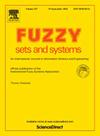利用视图权重和特征权重学习进行多视图证据 c-means 聚类
IF 3.2
1区 数学
Q2 COMPUTER SCIENCE, THEORY & METHODS
引用次数: 0
摘要
多视图聚类仍然是一项具有挑战性的任务,因为不同视图之间可能存在聚类重叠和变异,从而导致聚类分配的不确定性和不精确性。本文以信念函数(TBF)理论为基础,探讨了具有视图权重和特征权重学习(MVECM-VFL)的多视图证据 c-means 聚类。其目的是有效捕捉聚类分配中的不确定性和不精确性,同时评估聚类框架中视图权重和特征权重的贡献。我们将视图和特征权重以及信用分区整合到一个联合学习框架中,并设计了一个新的目标函数来寻找最佳结果。在 MVECM-VFL 中,每个对象都可以以不同的信念质量属于不同的聚类,从而表征了不确定性。此外,当一个物体位于多个单子簇的重叠区域时,它可以归属于一个元簇(定义为这些单子簇的联合),以表示簇分配中的局部不精确性。此外,视图权重和特征权重学习也有助于更好地获得可信分区。与相关方法相比,MVECM-VFL 基于合成数据集和真实数据集证明了其有效性。本文章由计算机程序翻译,如有差异,请以英文原文为准。
Multi-view evidential c-means clustering with view-weight and feature-weight learning
Multi-view clustering remains a challenging task due to the potential overlap of clusters and variability across different views, which causes uncertainty and imprecision in cluster assignment. This paper explores multi-view evidential c-means clustering with view-weight and feature-weight learning (MVECM-VFL), grounded in the theory of belief functions (TBF). The aim is to effectively capture the uncertainty and imprecision in cluster assignment while concurrently assessing the contributions of view and feature weights in the clustering framework. We integrate view and feature weights and credal partition into a joint learning framework and design a new objective function to find the best results. In MVECM-VFL, each object can belong to different clusters with various masses of belief, thereby characterizing the uncertainty. Furthermore, when an object resides in the overlapping area of several singleton clusters, it can be attributed to a meta-cluster (defined as the union of these singleton clusters) to represent the local imprecision in cluster assignment. Additionally, view-weight and feature-weight learning can help to obtain the credal partition better. Compared to the related methods, the effectiveness of MVECM-VFL is demonstrated based on synthetic and real-world datasets.
求助全文
通过发布文献求助,成功后即可免费获取论文全文。
去求助
来源期刊

Fuzzy Sets and Systems
数学-计算机:理论方法
CiteScore
6.50
自引率
17.90%
发文量
321
审稿时长
6.1 months
期刊介绍:
Since its launching in 1978, the journal Fuzzy Sets and Systems has been devoted to the international advancement of the theory and application of fuzzy sets and systems. The theory of fuzzy sets now encompasses a well organized corpus of basic notions including (and not restricted to) aggregation operations, a generalized theory of relations, specific measures of information content, a calculus of fuzzy numbers. Fuzzy sets are also the cornerstone of a non-additive uncertainty theory, namely possibility theory, and of a versatile tool for both linguistic and numerical modeling: fuzzy rule-based systems. Numerous works now combine fuzzy concepts with other scientific disciplines as well as modern technologies.
In mathematics fuzzy sets have triggered new research topics in connection with category theory, topology, algebra, analysis. Fuzzy sets are also part of a recent trend in the study of generalized measures and integrals, and are combined with statistical methods. Furthermore, fuzzy sets have strong logical underpinnings in the tradition of many-valued logics.
 求助内容:
求助内容: 应助结果提醒方式:
应助结果提醒方式:


